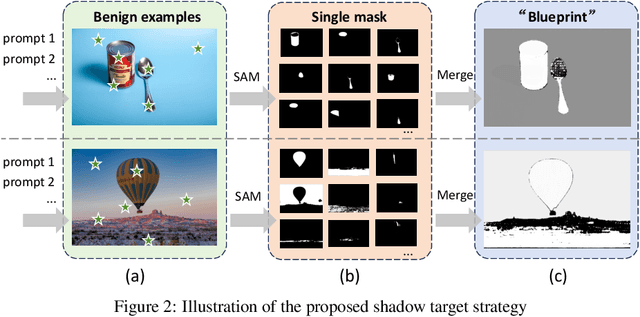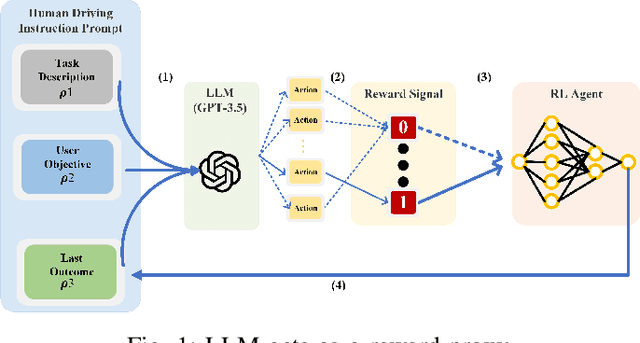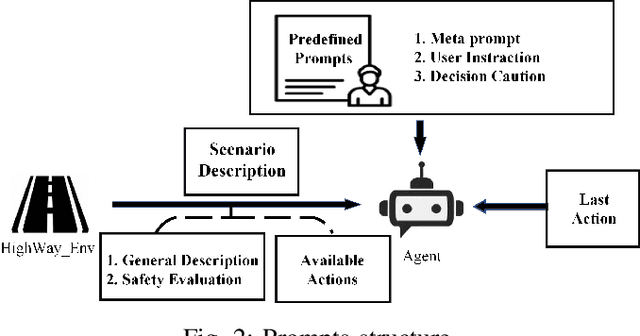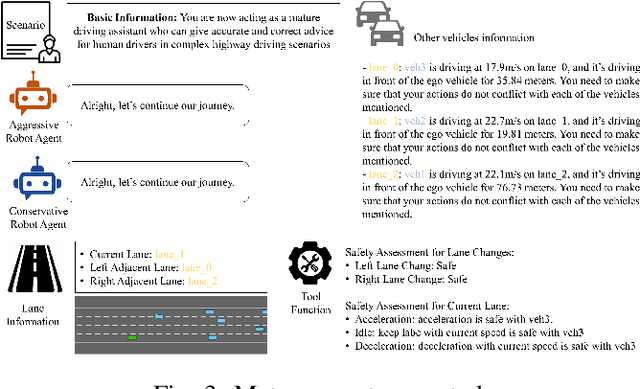Ziqi Zhou
Test-Time Backdoor Detection for Object Detection Models
Mar 19, 2025Abstract:Object detection models are vulnerable to backdoor attacks, where attackers poison a small subset of training samples by embedding a predefined trigger to manipulate prediction. Detecting poisoned samples (i.e., those containing triggers) at test time can prevent backdoor activation. However, unlike image classification tasks, the unique characteristics of object detection -- particularly its output of numerous objects -- pose fresh challenges for backdoor detection. The complex attack effects (e.g., "ghost" object emergence or "vanishing" object) further render current defenses fundamentally inadequate. To this end, we design TRAnsformation Consistency Evaluation (TRACE), a brand-new method for detecting poisoned samples at test time in object detection. Our journey begins with two intriguing observations: (1) poisoned samples exhibit significantly more consistent detection results than clean ones across varied backgrounds. (2) clean samples show higher detection consistency when introduced to different focal information. Based on these phenomena, TRACE applies foreground and background transformations to each test sample, then assesses transformation consistency by calculating the variance in objects confidences. TRACE achieves black-box, universal backdoor detection, with extensive experiments showing a 30% improvement in AUROC over state-of-the-art defenses and resistance to adaptive attacks.
Breaking Barriers in Physical-World Adversarial Examples: Improving Robustness and Transferability via Robust Feature
Dec 22, 2024



Abstract:As deep neural networks (DNNs) are widely applied in the physical world, many researches are focusing on physical-world adversarial examples (PAEs), which introduce perturbations to inputs and cause the model's incorrect outputs. However, existing PAEs face two challenges: unsatisfactory attack performance (i.e., poor transferability and insufficient robustness to environment conditions), and difficulty in balancing attack effectiveness with stealthiness, where better attack effectiveness often makes PAEs more perceptible. In this paper, we explore a novel perturbation-based method to overcome the challenges. For the first challenge, we introduce a strategy Deceptive RF injection based on robust features (RFs) that are predictive, robust to perturbations, and consistent across different models. Specifically, it improves the transferability and robustness of PAEs by covering RFs of other classes onto the predictive features in clean images. For the second challenge, we introduce another strategy Adversarial Semantic Pattern Minimization, which removes most perturbations and retains only essential adversarial patterns in AEsBased on the two strategies, we design our method Robust Feature Coverage Attack (RFCoA), comprising Robust Feature Disentanglement and Adversarial Feature Fusion. In the first stage, we extract target class RFs in feature space. In the second stage, we use attention-based feature fusion to overlay these RFs onto predictive features of clean images and remove unnecessary perturbations. Experiments show our method's superior transferability, robustness, and stealthiness compared to existing state-of-the-art methods. Additionally, our method's effectiveness can extend to Large Vision-Language Models (LVLMs), indicating its potential applicability to more complex tasks.
NumbOD: A Spatial-Frequency Fusion Attack Against Object Detectors
Dec 22, 2024Abstract:With the advancement of deep learning, object detectors (ODs) with various architectures have achieved significant success in complex scenarios like autonomous driving. Previous adversarial attacks against ODs have been focused on designing customized attacks targeting their specific structures (e.g., NMS and RPN), yielding some results but simultaneously constraining their scalability. Moreover, most efforts against ODs stem from image-level attacks originally designed for classification tasks, resulting in redundant computations and disturbances in object-irrelevant areas (e.g., background). Consequently, how to design a model-agnostic efficient attack to comprehensively evaluate the vulnerabilities of ODs remains challenging and unresolved. In this paper, we propose NumbOD, a brand-new spatial-frequency fusion attack against various ODs, aimed at disrupting object detection within images. We directly leverage the features output by the OD without relying on its internal structures to craft adversarial examples. Specifically, we first design a dual-track attack target selection strategy to select high-quality bounding boxes from OD outputs for targeting. Subsequently, we employ directional perturbations to shift and compress predicted boxes and change classification results to deceive ODs. Additionally, we focus on manipulating the high-frequency components of images to confuse ODs' attention on critical objects, thereby enhancing the attack efficiency. Our extensive experiments on nine ODs and two datasets show that NumbOD achieves powerful attack performance and high stealthiness.
PB-UAP: Hybrid Universal Adversarial Attack For Image Segmentation
Dec 21, 2024



Abstract:With the rapid advancement of deep learning, the model robustness has become a significant research hotspot, \ie, adversarial attacks on deep neural networks. Existing works primarily focus on image classification tasks, aiming to alter the model's predicted labels. Due to the output complexity and deeper network architectures, research on adversarial examples for segmentation models is still limited, particularly for universal adversarial perturbations. In this paper, we propose a novel universal adversarial attack method designed for segmentation models, which includes dual feature separation and low-frequency scattering modules. The two modules guide the training of adversarial examples in the pixel and frequency space, respectively. Experiments demonstrate that our method achieves high attack success rates surpassing the state-of-the-art methods, and exhibits strong transferability across different models.
GoHD: Gaze-oriented and Highly Disentangled Portrait Animation with Rhythmic Poses and Realistic Expression
Dec 13, 2024



Abstract:Audio-driven talking head generation necessitates seamless integration of audio and visual data amidst the challenges posed by diverse input portraits and intricate correlations between audio and facial motions. In response, we propose a robust framework GoHD designed to produce highly realistic, expressive, and controllable portrait videos from any reference identity with any motion. GoHD innovates with three key modules: Firstly, an animation module utilizing latent navigation is introduced to improve the generalization ability across unseen input styles. This module achieves high disentanglement of motion and identity, and it also incorporates gaze orientation to rectify unnatural eye movements that were previously overlooked. Secondly, a conformer-structured conditional diffusion model is designed to guarantee head poses that are aware of prosody. Thirdly, to estimate lip-synchronized and realistic expressions from the input audio within limited training data, a two-stage training strategy is devised to decouple frequent and frame-wise lip motion distillation from the generation of other more temporally dependent but less audio-related motions, e.g., blinks and frowns. Extensive experiments validate GoHD's advanced generalization capabilities, demonstrating its effectiveness in generating realistic talking face results on arbitrary subjects.
TrojanRobot: Backdoor Attacks Against Robotic Manipulation in the Physical World
Nov 18, 2024Abstract:Robotic manipulation refers to the autonomous handling and interaction of robots with objects using advanced techniques in robotics and artificial intelligence. The advent of powerful tools such as large language models (LLMs) and large vision-language models (LVLMs) has significantly enhanced the capabilities of these robots in environmental perception and decision-making. However, the introduction of these intelligent agents has led to security threats such as jailbreak attacks and adversarial attacks. In this research, we take a further step by proposing a backdoor attack specifically targeting robotic manipulation and, for the first time, implementing backdoor attack in the physical world. By embedding a backdoor visual language model into the visual perception module within the robotic system, we successfully mislead the robotic arm's operation in the physical world, given the presence of common items as triggers. Experimental evaluations in the physical world demonstrate the effectiveness of the proposed backdoor attack.
Unlearnable 3D Point Clouds: Class-wise Transformation Is All You Need
Oct 04, 2024Abstract:Traditional unlearnable strategies have been proposed to prevent unauthorized users from training on the 2D image data. With more 3D point cloud data containing sensitivity information, unauthorized usage of this new type data has also become a serious concern. To address this, we propose the first integral unlearnable framework for 3D point clouds including two processes: (i) we propose an unlearnable data protection scheme, involving a class-wise setting established by a category-adaptive allocation strategy and multi-transformations assigned to samples; (ii) we propose a data restoration scheme that utilizes class-wise inverse matrix transformation, thus enabling authorized-only training for unlearnable data. This restoration process is a practical issue overlooked in most existing unlearnable literature, \ie, even authorized users struggle to gain knowledge from 3D unlearnable data. Both theoretical and empirical results (including 6 datasets, 16 models, and 2 tasks) demonstrate the effectiveness of our proposed unlearnable framework. Our code is available at \url{https://github.com/CGCL-codes/UnlearnablePC}
DarkSAM: Fooling Segment Anything Model to Segment Nothing
Sep 26, 2024



Abstract:Segment Anything Model (SAM) has recently gained much attention for its outstanding generalization to unseen data and tasks. Despite its promising prospect, the vulnerabilities of SAM, especially to universal adversarial perturbation (UAP) have not been thoroughly investigated yet. In this paper, we propose DarkSAM, the first prompt-free universal attack framework against SAM, including a semantic decoupling-based spatial attack and a texture distortion-based frequency attack. We first divide the output of SAM into foreground and background. Then, we design a shadow target strategy to obtain the semantic blueprint of the image as the attack target. DarkSAM is dedicated to fooling SAM by extracting and destroying crucial object features from images in both spatial and frequency domains. In the spatial domain, we disrupt the semantics of both the foreground and background in the image to confuse SAM. In the frequency domain, we further enhance the attack effectiveness by distorting the high-frequency components (i.e., texture information) of the image. Consequently, with a single UAP, DarkSAM renders SAM incapable of segmenting objects across diverse images with varying prompts. Experimental results on four datasets for SAM and its two variant models demonstrate the powerful attack capability and transferability of DarkSAM.
ECLIPSE: Expunging Clean-label Indiscriminate Poisons via Sparse Diffusion Purification
Jun 25, 2024Abstract:Clean-label indiscriminate poisoning attacks add invisible perturbations to correctly labeled training images, thus dramatically reducing the generalization capability of the victim models. Recently, some defense mechanisms have been proposed such as adversarial training, image transformation techniques, and image purification. However, these schemes are either susceptible to adaptive attacks, built on unrealistic assumptions, or only effective against specific poison types, limiting their universal applicability. In this research, we propose a more universally effective, practical, and robust defense scheme called ECLIPSE. We first investigate the impact of Gaussian noise on the poisons and theoretically prove that any kind of poison will be largely assimilated when imposing sufficient random noise. In light of this, we assume the victim has access to an extremely limited number of clean images (a more practical scene) and subsequently enlarge this sparse set for training a denoising probabilistic model (a universal denoising tool). We then begin by introducing Gaussian noise to absorb the poisons and then apply the model for denoising, resulting in a roughly purified dataset. Finally, to address the trade-off of the inconsistency in the assimilation sensitivity of different poisons by Gaussian noise, we propose a lightweight corruption compensation module to effectively eliminate residual poisons, providing a more universal defense approach. Extensive experiments demonstrate that our defense approach outperforms 10 state-of-the-art defenses. We also propose an adaptive attack against ECLIPSE and verify the robustness of our defense scheme. Our code is available at https://github.com/CGCL-codes/ECLIPSE.
In-context Learning for Automated Driving Scenarios
May 07, 2024



Abstract:One of the key challenges in current Reinforcement Learning (RL)-based Automated Driving (AD) agents is achieving flexible, precise, and human-like behavior cost-effectively. This paper introduces an innovative approach utilizing Large Language Models (LLMs) to intuitively and effectively optimize RL reward functions in a human-centric way. We developed a framework where instructions and dynamic environment descriptions are input into the LLM. The LLM then utilizes this information to assist in generating rewards, thereby steering the behavior of RL agents towards patterns that more closely resemble human driving. The experimental results demonstrate that this approach not only makes RL agents more anthropomorphic but also reaches better performance. Additionally, various strategies for reward-proxy and reward-shaping are investigated, revealing the significant impact of prompt design on shaping an AD vehicle's behavior. These findings offer a promising direction for the development of more advanced and human-like automated driving systems. Our experimental data and source code can be found here.
 Add to Chrome
Add to Chrome Add to Firefox
Add to Firefox Add to Edge
Add to Edge